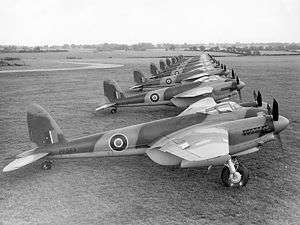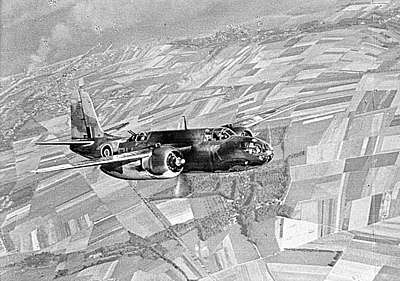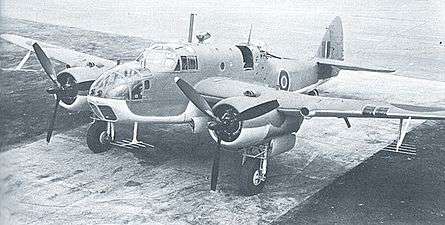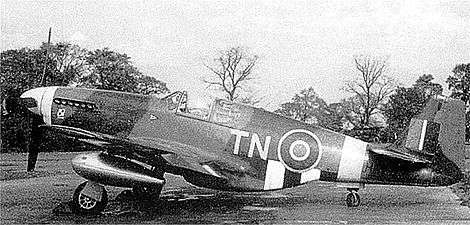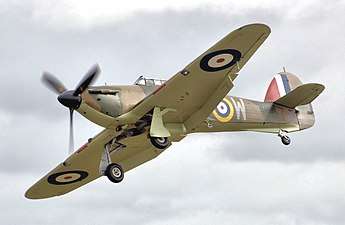RAF Twinwood Farm
RAF Twinwood Farm is a former Royal Air Force (RAF) station located 4 mi (6.4 km) north of Bedford, Bedfordshire, England. For the majority of World War II, the airfield was home to RAF night fighters.
RAF Twinwood Farm .png) | |||||||||||||||||||
|---|---|---|---|---|---|---|---|---|---|---|---|---|---|---|---|---|---|---|---|
 Aerial photograph, 28 March 1948. | |||||||||||||||||||
| Summary | |||||||||||||||||||
| Airport type | Military | ||||||||||||||||||
| Owner | Air Ministry | ||||||||||||||||||
| Operator | Royal Air Force United States Army Air Forces | ||||||||||||||||||
| Location | Bedford, Bedfordshire | ||||||||||||||||||
| Elevation AMSL | 24 ft / 80 m | ||||||||||||||||||
| Coordinates | 52°10′52″N 0°29′10″W | ||||||||||||||||||
| Website | www | ||||||||||||||||||
| Map | |||||||||||||||||||
 RAF Twinwood Farm Location in Bedfordshire | |||||||||||||||||||
| Runways | |||||||||||||||||||
| |||||||||||||||||||
Royal Air Force use
Twinwood Farm opened in mid 1941 when the RAF began to use the grassed field. By April 1942 it had three concrete runways and additional temporary buildings.
From then until the end of the war the Bristol Blenheims, Bristol Beaufighters, Bristol Beauforts, Douglas Havocs and de Havilland Mosquitoes of No. 51 Operational Training Unit used 'Twinwoods', as it was generally known.[1]
Gallery - RAF aircraft operated at airfield
|
Other RAF Squadrons
- No. 26 Squadron RAF.[2]
- No. 268 Squadron RAF.[3]
- No. 613 Squadron RAF.[4]
- No. 169 Squadron RAF.[5]
- No. 239 Squadron RAF.[6]
In March 1943 North American Mustangs belonging to 164, 169, 239 and 208 Squadrons RAF engaged in Operation Spartan[1] which occurred between 1 and 12 March 1943 was conducted across southern and central England to test a wide range of procedures and tactics of British and Canadian Forces.[7]
United States Army Air Forces use
In 1944 the airfield was transferred to the U.S. Eighth Air Force and operated in conjunction with the nearby RAF Thurleigh.[1]
Glenn Miller
Twinwood Farm was where USAAF Major Glenn Miller's aircraft took off on 15 December 1944 for Paris. His plane disappeared over the English Channel and was never found.
Current use
The airfield closed in June 1945.[8]
The site is now home to the Twinwood Arena,[9] a large natural amphitheatre which plays host to various music festivals promoted by Twinwood Events[10] including the Rhythm Festival.
Glenn Miller Museum
The Glenn Miller Museum is located in the restored control tower and features displays about Glenn Miller, RAF Twinwood Farm, and the Second World War.
Other buildings house different displays including:
- Twinwood Aviation Museum - featuring uniforms and artifacts recovered from German and Allied aircraft crash sites, as well as British aviation units and life in Britain during the war.
- Rooms of a 1940s family home
- Axis Museum - recreation of a German bunker, Russian and German artillery and weapons, and a display about Winston Churchill and the British Royal Family
- Fire Service Museum - recreated 1940s wartime fire station with uniforms, equipment and vehicles
- Displays of military vehicles
The group of museums are also known as Twinwood Airfield Museum, and are open seasonally.
References
Citations
- Twinwood Airfield Bedfordshire. Wartime Airfield Layout 1944 (website accessed: 28/07/10) Archived 24 August 2001 at the Wayback Machine
- Jefford 1988, p. 33.
- Jefford 1988, p. 81.
- Jefford 1988, p. 100.
- Jefford 1988, p. 64.
- Jefford 1988, p. 76.
- Modern Air - Fowlmere Aerodrome – a brief history (by Vic Flintham, Dec 2004) (website accessed:28/07/10) Archived 22 October 2010 at the Wayback Machine
- Travelling Days _ Bedford and District *(website accessed: 29/07/10)
- twinwood arena Archived 20 April 2008 at the Wayback Machine
- Glenn Miller Festival and Rhythm Festival at Twinwood Arena
Bibliography
- Jefford, C G (1988). RAF Squadrons. A comprehensive record of the movement and equipment of all RAF squadrons and their antecedents since 1912. Shrewsbury: Airlife. ISBN 1-85310-053-6.
External links
| Wikimedia Commons has media related to RAF Twinwood Farm. |
- Aerial photo of RAF Twinwood Farm from Multimap.Com
- Twinwood Farm historical photo album
- Twinwood Airfield Museum - site of Glenn Miller Museum (domain expired)
- Twinwood Airfield Bedfordshire. Wartime Airfield Layout 1944

